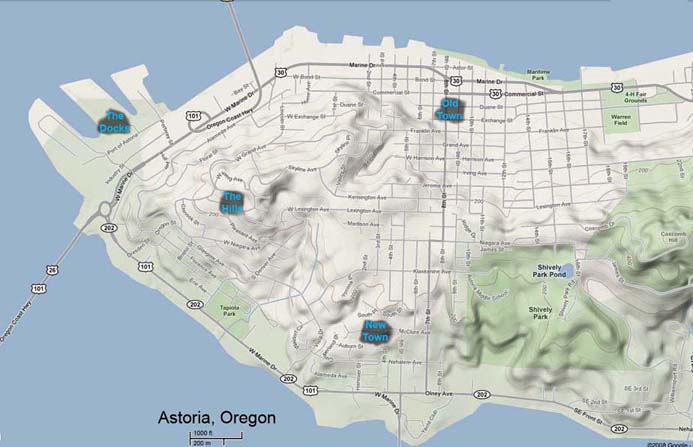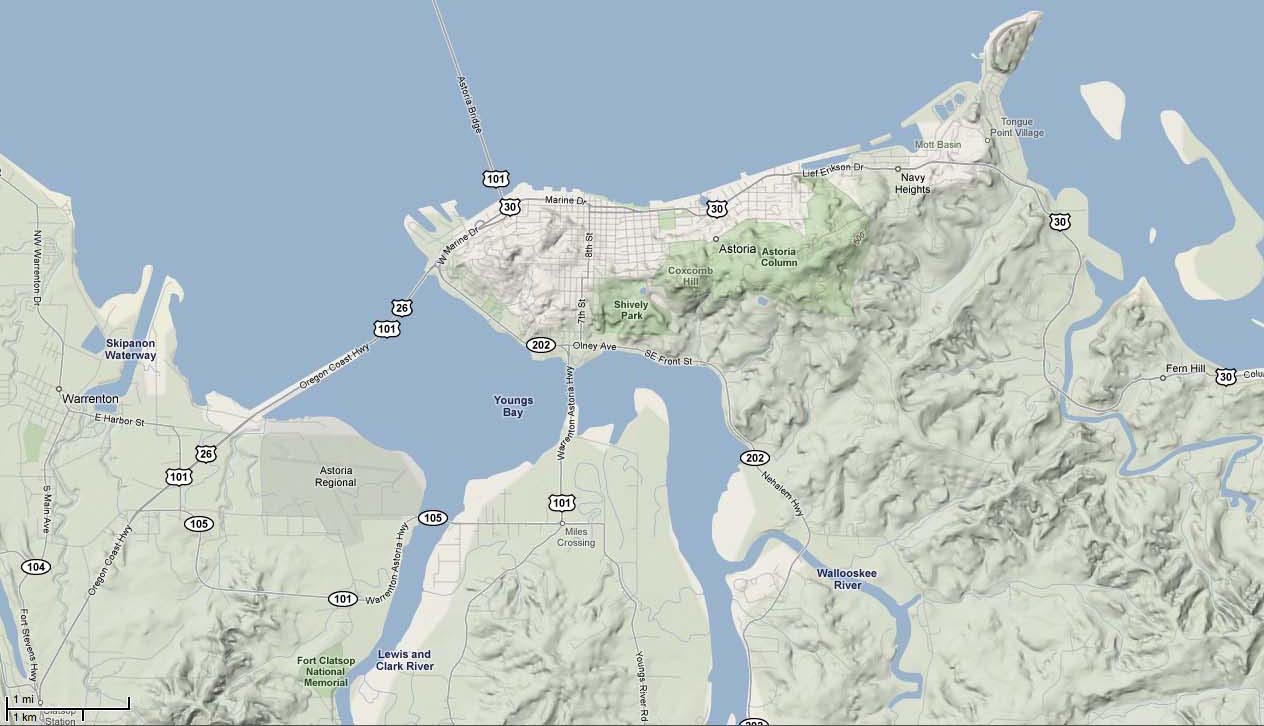Difference between revisions of "Astoria"
| Line 18: | Line 18: | ||
* '''1:''' The [http://en.wikipedia.org/wiki/Astoria_Column Astoria Column], a 125-foot tall painted column with an observation deck on top that sits on a hill overlooking Astoria. | * '''1:''' The [http://en.wikipedia.org/wiki/Astoria_Column Astoria Column], a 125-foot tall painted column with an observation deck on top that sits on a hill overlooking Astoria. | ||
* '''2:''' The Hotel Regina, an old abandoned hotel. | * '''2:''' The Hotel Regina, an old abandoned hotel. | ||
| + | * '''3:''' [http://www.clatsopcollege.com/about/index.html Clatsop Community College], a public two-year college that serves northwest Oregon and southeast Washington. | ||
===Facts & Figures=== | ===Facts & Figures=== | ||
Revision as of 19:03, 21 October 2008
Contents
Astoria, Oregon

|
Population: 10,045
Class: Middle Class (primarily)
A small town in the northwest corner of Oregon along the coast, Astoria is an old fishing and fur-trading settlement on land that was originally occupied by the Clatsop tribe. Named for its first millionaire, John Jacob Astor, Astoria grew up around the fort founded by Astor's fur trading company in 1810. It also boasts a deep water port that sees very little shipping trade, though it still maintains a decent fishing industry. It is also a port of call for a number of cruise lines sailing up and down the West Coast. This port attracted a number of immigrants in the late Nineteenth Century, mainly Scandinavians (particularly Finns, who worked the fisheries) and Chinese (who found work in the canneries).
Area Stats
- Physical: Access +1, Safety +1. Astoria has decently maintained streets and one or two cab companies, but most people need cars or at least bicycles to get around effectively. It is moderately patrolled and people have some measure of protection, but not much happens here, so the police aren't too curious nor the citizenry too diligent about locking doors or maintaining security systems.
- Mental: Information +3, Awareness -1. Though the physical lay of the land doesn't have much in the way of open line of sight (too much foliage for that), security cameras and a lassitude that leaves street lights or sidewalk lamps burnt out a little too long sometimes, it's a small town, and so everyone seems to know everything.
- Social: Prestige +0, Stability +2. Astoria is considered "one of those tiny coastal towns" by most people in the area, though no one really thinks ill of it. It's people are tightly knit and keep an eye out for one another.
- Sanctum Qualities: Up to Size 4. Though there are a variety of larger buildings, Astoria simply doesn't have any buildings to warrant a Size 5 Sanctum without special consideration.
Noteworthy Sites
- 1: The Astoria Column, a 125-foot tall painted column with an observation deck on top that sits on a hill overlooking Astoria.
- 2: The Hotel Regina, an old abandoned hotel.
- 3: Clatsop Community College, a public two-year college that serves northwest Oregon and southeast Washington.
Facts & Figures
Astoria is a city of 10,000 people on the Columbia River, just a few miles from the Pacific Ocean located in Clatsop County. It is surrounded by the beauty of the forest, mountains, 3 rivers and the sea. Because of its steep hills and beautiful Victorian homes, Astoria has been Called the “Little San Francisco of the Pacific Northwest.” Just across Youngs Bay is Warrenton, a city of 4,500, that encompasses Fort Stevens State Park and its broad, clean ocean beaches.
Astoria and Warrenton have a marine climate, which means the summers are cool, with highs around 70, and the winters are mild, with few nights of freezing temperatures. The area gets about 75 inches of rain per year, which accounts for its vivid greenness and crystal clear air. Winter storms can be dramatic with winds reaching 70 to 100 miles per hour on the ocean bluffs. The area has a strong Scandinavian heritage.
History
In May, 1792, American Captain Robert Gray sailed his 230-ton Columbia Rediviva between Point Adams in what is now Oregon and Cape Disappointment in what is now Washington to first enter the Columbia River. Ten years later, President Thomas Jefferson asked his personal secretary, Army Captain Meriwether Lewis, to lead an expedition to the Pacific to find “...whether the Columbia, Oregen, Colorado, or any other river may offer the most direct and practicable water communication across this continent for the purposes of commerce”.
The Lewis and Clark Expedition left Pittsburgh August 31, 1803. The Corps of Discovery entered the Lower Columbia River in November of 1805 and stayed through March 1806. They “wintered over” at Fort Clatsop, where it rained all but 12 days, hunting, making moccasins and other clothing, trading with the Clatsop, Tillamook, and Chinook Indians, and working on their journals.
In 1811, five years after the departure of Lewis & Clark, John Jacob Astor, a New York financier, sent fur traders aboard the ship Tonquin to establish a trading post. They built Fort Astoria on a site now preserved as a monument in the downtown area.
Well over 200 major shipwrecks have occurred near the mouth of the Columbia River – known for a century as “The Graveyard of the Pacific.” One, the Peter Iredale of 1906, is still visible on the beach at Fort Stevens State Park. Native Americans lived in the area for an estimated 10,000 years before Captain Gray’s arrival.
Nearby Areas

|
- Astoria Regional Airport, a small municipal airport
- CGAS Astoria, a Coast Guard Air Station located at the Astoria Regional Airport
- Warrenton, a nearby town (pop. 4300)
- Other Small Towns
- All of the following have populations of less than 500, and many of only a few hundred
- Hammond, a small town absorbed by Warrenton.
- Navy Heights
- Tongue Point Village
- Youngs River & Bay
- Fern Hill
- Svensen
- Olney
- Lilleas & Estoos
- Clatsop Spit, a massive sand flat responsible for many shipwrecks.
- The Peter Iredale shipwreck